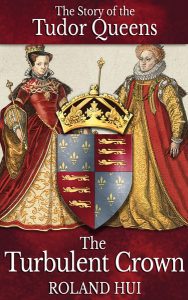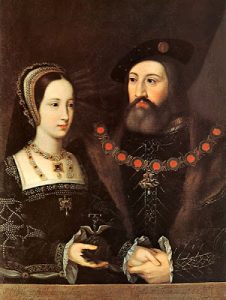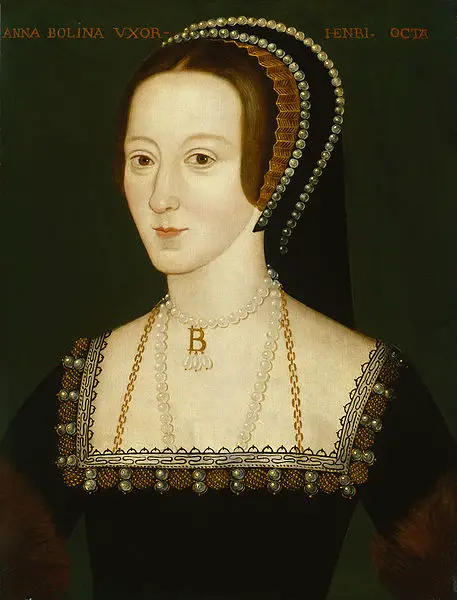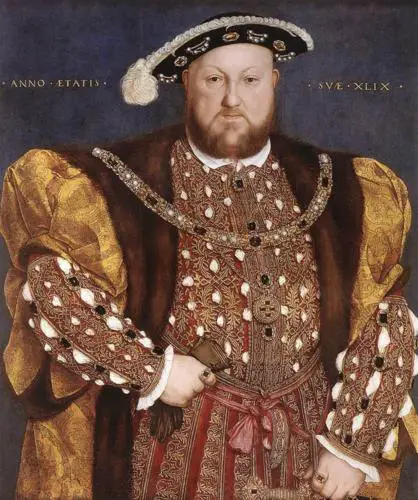Thank you to Simon for asking the question "What is Mary Tudor holding in the portrait of her and Charles Brandon? Is it an artichoke?". I knew just the right person to send this question to! I sent it to art historian and author, Roland Hui, who has actually written a very detailed article on this painting (link at bottom). Thank you Roland!
The object in Mary Tudor's right hand is an artichoke, which interestingly enough is shaped like a royal orb. It is uncertain why Mary is pictured with one, but as artichokes were grown in the south of France, it may have been used to allude to her as France's former Queen. As well, it might have been meant as a symbol of love and fecundity. Artichokes were said to be sacred to Venus/Aphrodite, the Classical goddess of love and beauty.
The staff emerging from the artichoke is a winged caduceus. This was the magical wand associated with the god Mercury/Hermes. There was an old legend that Mercury had come upon two battling snakes. To make peace between them, the god separated the two with a stick. The serpents then wrapped themselves around it. This uniting of opposites was a fitting representation of Mary Tudor and Charles Brandon's marriage - the merger of 'cloth of gold' and 'cloth of frieze' as the couple were described in an inscription on the Yarnborough version of the painting. However, to make the caduceus (and the artichoke) appear less 'pagan', the wand is also in the form of a Christian tau-shaped cross.
To learn more about the painting of Mary Tudor and Charles Brandon, please see https://tudorfaces.blogspot.com/2013/07/the-brandon-wedding-portrait-some-new.html.
Roland Hui received his degree in Art History from Concordia University in Canada. After completing his studies, he went on to work in Interpretive Media for California State Parks, The U.S. Forest Service, and The National Park Service.
Roland has written for Renaissance Magazine and for Tudor Life Magazine. He blogs about 16th-century English art and personalities at tudorfaces.blogspot.com. He is also the author of The Turbulent Crown: The Story of the Tudor Queens:
 Ten remarkable women.
Ten remarkable women.
One remarkable era.
In the Tudor period, 1485–1603, a host of fascinating women sat on the English throne. The dramatic events of their lives are told in The Turbulent Crown: The Story of the Tudor Queens of England.
The Turbulent Crown begins with the story of Elizabeth of York, who survived conspiracy, and dishonour to become the first Tudor Queen, bringing peace and order to England after years of civil war. From there, the reader is taken through the parade of Henry VIII’s six wives – two of whom, Anne Boleyn and Katheryn Howard, would lose their heads against a backdrop of intrigue and scandal.
The Turbulent Crown continues with the tragedy of Lady Jane Grey, the teenager who ruled for nine days until overthrown by her cousin Mary Tudor. But Mary’s reign, which began in triumph, ended in disaster, leading to the emergence of her sister, Elizabeth I, as the greatest of her family and of England’s monarchs.




I think mr. Hui should correct his interpretation
The name of the artichoke comes from the Greek mythology.
There was a beautiful nimph of the woods called Cynara, hairs of the colour of the ashes
and green eyes with violet hues. Zeus was in love madly with her, but Cynara refused him, so Zeus transformed Cynara in the plant.
Consequently, being the Artichoke a medical plant (a powerful detox) is normal that
a caduceus is associated with it. It is a symbol of Mercurius’ beloved disciple, that is Asclepius, semi-god of the medicine.